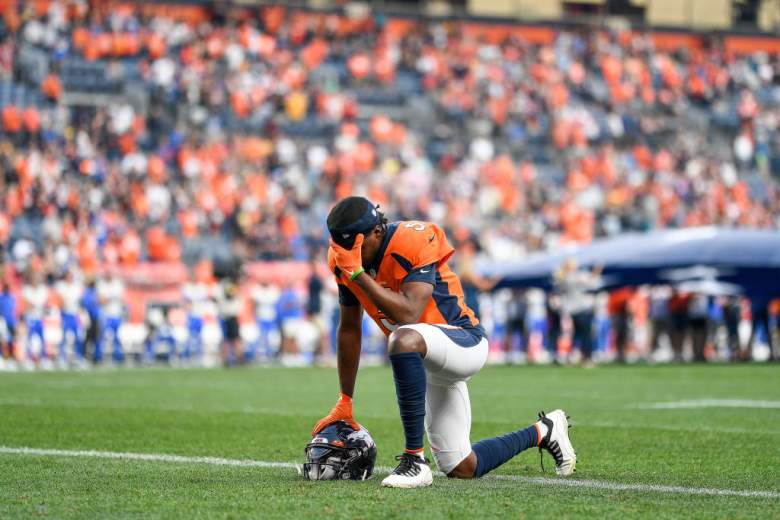
Getty Inept first-down execution and slow first-quarter starts have become a headache for quarterback Teddy Bridgewater and the Denver Broncos' offense.
As the hated Las Vegas Raiders invade Empower Field at Mile Stadium for their October 17 matchup with the Denver Broncos, it should be noted that both squads have been reeling as of late.
Denver and Las Vegas both started the season winning their first three games, respectively, but since, they’re both now on two-game losing streaks.
The Raiders (3-2) have issues on and off the field, as it’s been well documented, while the matters that have plagued the Broncos (3-2) have been mostly self-inflicted on-field troubles.
ALL the latest Broncos news straight to your inbox! Join the Heavy on Broncos newsletter here!
Start Fast!
The Broncos began the season unbeaten, knocking off teams that many considered also-rans. And while the plus-50 points differential was impressive against the New York Giants (1-4), the Jacksonville Jaguars (0-5), and New York Jets (1-4), there were still offensive issues bubbling just below the surface.
The key to beating the Raiders is to get off to a fast and aggressive start, something the Broncos haven’t done much of, even during their winning streak. Insufficient yardage on first downs and slow overall starts in the opening quarter, led to quick deficits on the scoreboard — even against dregs like the Giants and Jaguars.
Those problems didn’t fully show themselves against the bad teams, but in consecutive losses to the Baltimore Ravens (4-1) and Pittsburgh Steelers (2-3), the Broncos couldn’t muster much on crucial downs, which made extending drives nearly impossible. Against the Ravens and Steelers, the Broncos could only muster three touchdowns in 21 possessions, and converted just seven of 26 third-down plays.
Denver not only has issues on first down, where it’s ranked 31st in first-down efficiency (considered a play that gains four-plus yards), but on third down as well, where it’s the only squad in the NFL under 30.5%, at a horrid 28.7%, and one of only seven teams under a 35% clip. The league average is 40.6%. The Broncos had 51 first-down snaps in their two losses and gained three or fewer yards on 26 plays — a 50.9% rate. Even the Jaguars (59%) own a better rate. Such circumstances put the offense in a bind on second downs, particularly in the Steelers contest, where Denver’s second downs were a constant struggle, averaging 2nd-and-8 on 18 second down attempts.
Avoid Third-and-Long Situations
Unsuccessful or short gains on second down, led to third-and-long situations — and the Broncos’ margin of error isn’t as great as the elite teams in the league. They need to stay on script and have manageable down-and-distance situations.
Denver’s strong start on third downs against the Giants, when it converted 7-of-15 attempts, is a thing of the past, as since the opener, the success rate has drastically decreased to a league-worst 11 total conversions in the four successive games.
Embattled offensive coordinator Pat Shurmur supposedly has the elixir.
“You have to have more success on first and second down, especially early in the game,” said Shurmur, seemingly auditioning for the Captain Obvious role.
The coach then added optimism, believing the offense isn’t that far away from turning around its fortunes.
“We have some growing pains that we’ve gone through, but we’re playing better in a lot of areas,” Shurmur said following the October 15 practice. “There are some areas we have to continue to get better at.”
Shurmur’s blind and misguided confidence aside, there are real issues for the Broncos. The longer the yards needed to convert third downs, the longer the odds. Plays that needed three to seven yards were converted at a 37% rate (10-of-27), while eight yards or more was a 22.2% clip (8-of-36).
Just go for it
Perhaps the Broncos should simply eschew third downs altogether, as they are actually the most successful team on fourth downs. The Broncos’ eight conversions lead the NFL (on nine attempts), and are already more than any of the Denver teams in 2010 (six conversions), 2011 (three), 2012 (three), 2014 (six), 2015 (seven), 2017 (seven), and 2020 (four). It should be noted that the average distance on those 2021 fourth-down attempts is only 2.9 yards — but the players certainly appreciate head coach Vic Fangio’s faith in them.
Shurmur needs to allow quarterback Teddy Bridgewater to open up the offense and test the Raiders’ secondary downfield. Even without wideouts Jerry Jeudy (ankle, but due to return shortly) and KJ Hamler (ACL, out for the season), Bridgewater has shown he can push the ball downfield. The veteran signal caller has a robust 100.7 rating on passes that travel at least 16 “air” yards (the distance between the time the ball leaves the quarterback’s hands and the time it arrives at the intended target), as he’s 12-of-28 for 343 yards, one touchdown, and no interceptions.
Follow Tony Williams on Twitter: @TBone8
Comments
What the Broncos Must Do to Beat the Jon Gruden-Less Raiders